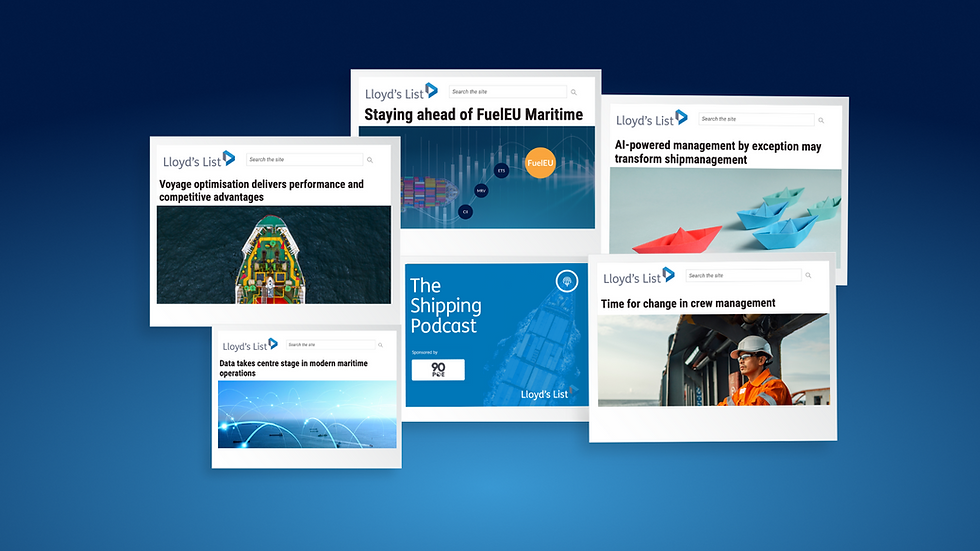The Changing Tides of Maritime Emissions: What the Revised EU ETS Regulation Means for Shipping.
- rosystaines
- Dec 4, 2023
- 4 min read
Updated: May 30, 2024

The European Union is taking a bold step forward in its fight against climate change by expanding its Emissions Trading System (EU ETS) to include the maritime sector.
Building on the revised EU Monitoring, Reporting and Verification regulation (MRV), this significant policy shift, set to take effect at the very start of 2024, mandates ship owners, operators and managers to monitor, report, and surrender allowances for CO2 emissions, posing new challenges in terms of compliance and operational costs. The maritime industry, responsible for a substantial portion of global trade, now faces the daunting task of adapting to these stringent regulations while maintaining efficiency and profitability - and it doesn’t stop here. Equivalent schemes to the EU ETS are likely to be mirrored by other sovereign states in the coming years, as countries around the world work to reduce greenhouse gas emissions.
We look at some of the key details around the upcoming EU ETS and explore how OpenOcean STUDIO can help ship owners, operators and managers navigate these changing tides.
What is the EU ETS?
The EU ETS is a market-based system designed to reduce greenhouse gas emissions across various industries, including power generation, manufacturing, and now, shipping. At present the EU ETS covers Carbon Dioxide, however from 2026 this will be extended to include Methane and Nitrous Oxide and applies to all ships of 5000 gross tonnage and above, entering EU waters and have an EU port of call.
The new regulations operate on a cap-and-trade principle, setting a limit on the total amount of emissions allowed and permitting companies to trade allowances, representing the right to emit.
These allowances, or EUAs as they are known, are set to be tracked by Union Registry with every shipowner, operator and manager requiring an account to surrender EUAs for the first time in 2025, and for transferring EUAs to stakeholders across the maritime value chain.
Key Features of the Revised EU ETS for Shipping
Phased implementation
The revised EU ETS for shipping will introduce a phased implementation approach, gradually increasing the percentage of emissions covered by the system:
2024 - Companies will pay for 40% of their emissions from the previous year.
2025 - Companies will pay for 70% of their emissions from the previous year.
From 2026 onwards - Companies will pay for 100% of their emissions from the previous year.
This incremental approach aims to provide the industry with time to adjust and invest, while still sending a strong price signal to reduce emissions.
Scope – Vessels
Ships 5000 GT and above, transporting cargo or passengers for commercial purposes will be covered from 1 January 2024.
Scope - Emissions
100% of the emissions from intra-EU maritime voyages
100% of emissions from ships at berth in EU ports
50% of emissions from voyages which start or end at EU ports, where the other destination is outside of the EU.
How the EU ETS is set to impact the sector
While the financial implications are significant, the broader regulatory landscape poses the most substantial challenge for ship owners, operators and managers. Managing a diverse fleet amidst increased voyage planning complexities and stricter reporting requirements demands a new level of operational decision-making.
Moreover, the varied coverage of emissions – 100% within EU ports and 50% for voyages starting or ending outside of the EU – requires meticulous data tracking and analysis.
All of this is compounded by the fact that a failure to comply with these requirements can result in significant penalties.
Turning Challenge into Opportunity
Despite these challenges, EU ETS presents an opportunity for the maritime sector to enhance emissions management, sustainability practices and embrace technology.
This is where innovative technology solutions like 90POE’s OpenOcean STUDIO can help.
Changing Tide: Embracing the Future with OpenOcean STUDIO
Built by the industry, for the industry, OpenOcean STUDIO is enabling effective emissions management ensuring vessel owners and operators actively manage their emission exposure.
From initial CII & ETS exposure capture through to active monitoring, reporting, and verification OpenOcean STUDIO ensures operators and owners stay in control.
Estimate and manage emissions - The OpenOcean STUDIO voyage estimator tool incorporates CII and EU ETS estimations, enabling companies to accurately calculate their emissions and costs ahead of fixture. Voyage execution can be explored to minimise exposure with active voyage monitoring enabling key operational decision making to remain on target. OpenOcean STUDIO captures post voyage insights and eases verification through verification providers.
Ensure data accuracy and compliance - Either through our dedicated onboard solution or by integration with existing systems, OpenOcean STUDIO ensures all the necessary reporting information is accurately captured to ease verification and ensure compliance with EU ETS requirements and beyond.
Stay in control - OpenOcean STUDIO provides reporting discipline, predictive modelling, alerts, and ease of workflow. Intuitive dashboards, including real-time ETS exposure. This ensures not just compliance, but also enables strategic decision-making allowing owners, operators and managers to stay in control.
While the EU ETS and increased regulations to come present significant challenges for the maritime sector it also steers in an era of innovation and sustainability.
Richard Buckley, Founder & CEO of 90POE comments:
'With OpenOcean STUDIO, the maritime industry can not only adapt to but thrive in the face of these changing tides. We believe our platform offers a comprehensive ETS compliance solution that supports you from planning to execution, reporting to verification. With OpenOcean STUDIO, managing ETS becomes an integrated, hassle-free part of your maritime operations.'
Contact 90POE today to learn more about how we can help you stay competitive, compliant, and sustainable in our open oceans.




Comments